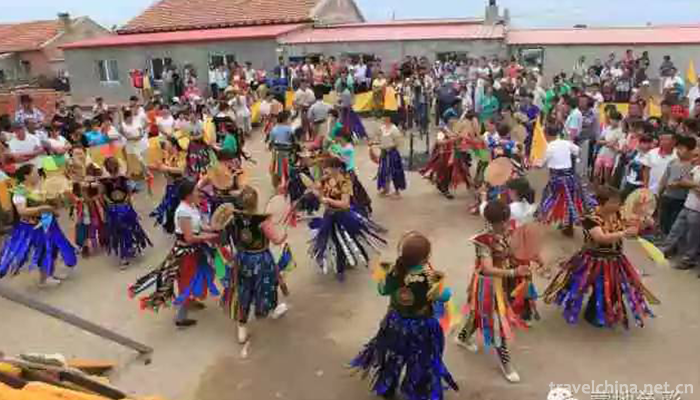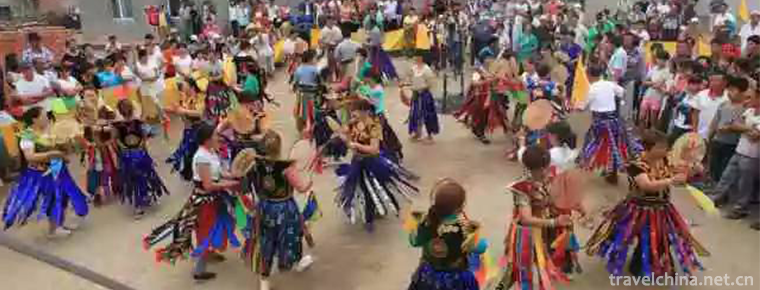Bo dance
Bo dance
Horqinbo dance, a primitive religious dance, is a form of Mongolian Bo (Shaman) "Xingbo" (Dancing God) and sacrifice. It is characterized by the combination of inspiration, singing and dancing, and has the characteristics of self-entertainment, competitiveness and play, which contains teaching in appreciation and entertainment.
origin
"Shaman" originates from the Chinese translation of Tungusian, meaning "a person who dances with excitement". History books generally refer to "Hu Wu", Mongolian people refer to male Shaman as "Bo" and female Shaman as "Odugan". Horqinbo dance is mainly used for offering sacrifices for blessings and exorcising evil spirits and curing diseases. Sacrifices for blessings are usually held in outdoor venues, including sacrifices to heaven and earth, ancestors, fire, thunder, mulberry trees, Aobao and rain, while exorcism and treatment are carried out at night at the home of patients.
details
When Bo dances, his skirt floats like a bird's wings and a horse's feet. In addition, the flickering of bronze mirrors and the sound of loud impact, the sound of drumming and shaking, make people dazzled and feel majestic. Horqin Bo Dance is mainly performed by Bo himself. When "Bang Bo" (two gods) participate in it, there are two-person dance and four-person dance. Their travel process and performance sequence are preparation, altar setting, dressing, table setting, elf box and sword. The first section invites God to worship and dance. The dancer's mood is sacred and pious, mainly singing, accompanied by simple footwork and "eight worship" movements. The second part of Shenlai Dance, the dancer's emotional fanaticism and confusion, with fierce rotation and jumping movements as the main, to dialogue, began to exorcise the evil and cure the disease, divination auspicious. Some Bo also danced Elf Dance according to the gods he came from. "Spirit Dance" is named for its imitation of totem gods, such as "Bird God Dance" and "Tiger God Dance". Most of them are singing and dancing, with rich movements and vivid images. The third part is for the entertainment of God dance, performing "Drum Dance" and "Elf Dance" with drumming skills throughout the dance. "Drum Dancing" moves lightly, skillfully and skillfully, drum point rich and changeable. "Elf Dance" adds gameplay to attract audiences and achieve the purpose of entertaining both people and gods. The fourth dance is basically the same as the first one.
"Laiqing" is a branch of Horqinbo, which is the product of the fierce struggle between Lamaism and Shamanism, so some people call it "Lamaibo". Lai Qing sat on a stool, beating radicals and chanting classics for treatment. Lai Qing's teacher-successor relationship and apprenticeship ceremony are the same as Bo's. But its costumes, instruments, dance movements, performance forms and music accompaniment are different from Bo. Dance is divided into cymbal dance, knife dance and bare-handed dance with different props, without drums or rotations.
Many Bo dances in Horqin are basically the same, but with different styles. Its artistic style of singing and dancing and drumming has been used for reference and developed by the new Mongolian dance art.


-
1.zhangjiajie national forest park Avatar Filming place
Zhangjiajie national Forest Park is located in Zhangjiajie City, northwest of Hunan province. On September 25, 1982, with the approval of the State Council of the People's Republic of China
Time 2018-10-28 -
2.Wonton Noodle
The wonton noodle is also called the bamboo rising face. It is a characteristic snack in Guangzhou. It originated in Guangzhou and Guangdong cuisine
Time 2018-11-14 -
3.Bijiashan Scenic Area
Bijiashan Scenic Area is located in Tianqiao Town, Jinzhou City, Liaoning Province. The main scenic spots are Bijiashan Island and "Tianqiao", which are divided into five areas: island sight
Time 2019-01-02 -
4.Muzhaling Luoyang
Located in Checun Town, Songxian County, Luoyang City, Henan Province, Luoyang Muzhaling is a National Nature Reserve of Funiu Mountain and a world geological park.
Time 2019-02-06 -
5.Ming Yue Mountain
Mingyue Mountain Tourist Area of Yichun City, Jiangxi Province, is located 15 kilometers southwest of Yichun Central City, with an area of 104 square kilometers.
Time 2019-02-07 -
6.Korean Huajiali
The flower armor ceremony of the Korean nationality is one of the important rituals of the Korean nationality's birthday ceremony. Since ancient times, the Korean people have regarded respecting the e
Time 2019-04-16 -
7.Han Embroidery
Han embroidery, one of the traditional embroidery techniques with Chinese characteristics, is based on Chu embroidery, which combines the merits of various
Time 2019-05-02 -
8.Western Fujian drama
Western Fujian Han Opera, formerly known as "Waijiang Opera", also known as "Ran Tan", is one of the local operas in Fujian. He was born out of foreign operas, absorbed Hakka diale
Time 2019-06-05 -
9.Pingyao Shage Player
Pingyao Shage Opera, commonly known as Shage Renren, also referred to as Shage, is one of the traditional handicraft techniques in Pingyao, Shanxi Province. Because it was usually placed in the cabine
Time 2019-06-09 -
10.Youyang Folk Songs
Youyang folk song is a rich and colorful folk culture created and accumulated by the Tujia, Miao and Han people in Youyang Tujia and Miao Autonomous County of Chongqing in the long practice of product
Time 2019-07-14 -
11.Zhulang Niangmei
Zhulang Niangmei is a work of Dong Opera in Guizhou Province. At the end of the Qing Dynasty, Liang Yaoting and Liang Shaohua, Dong opera masters in Congjiang County, Guizhou Province, adapted Dong dr
Time 2019-08-10 -
12.Administrative division of Mianyang
Mianyang City has jurisdiction over 9 county-level administrative divisions (Municipal District 3, county-level city 1, county-5), 166 township level administrative divisions (street 13, town 122, township 31), and manages the Science City Office of Sichuan
Time 2020-12-14